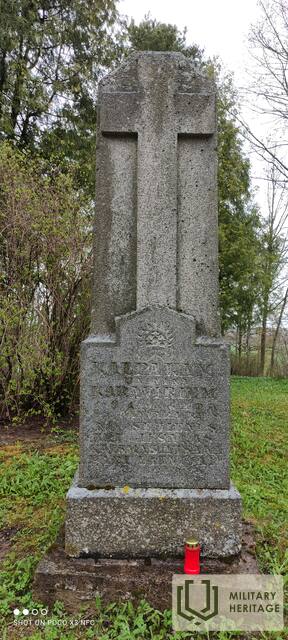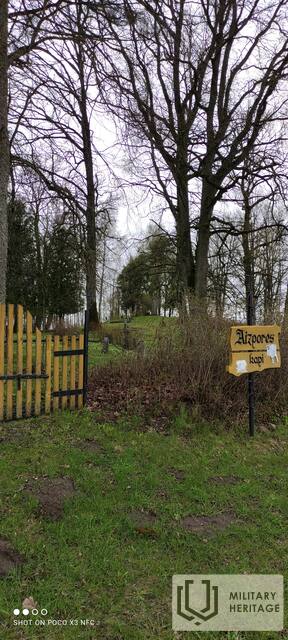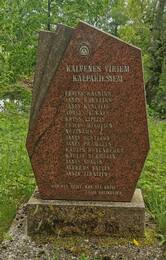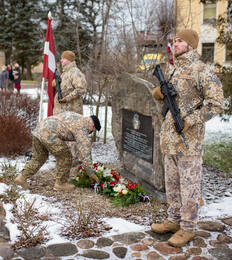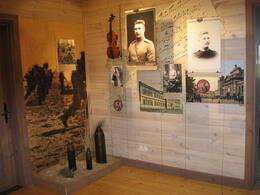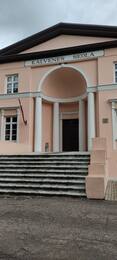Aizporu poolmõis Vabadussõjas
Aizporu poolsaar, Aizpute rajoon, Kalvene vald, on läänepoolseim koht Lätis, kuhu kolonel Oskars Kalpaksi eraldi pataljon taganes.
Rudbārži ja Kalvenė poolsaarel on Aizpore kalmistu. Seal on mälestusmärk ja 12 mälestusmärki Oskars Kalpaka pataljoni vabatahtlikele sõduritele.
1919. aasta jaanuaris, pärast lahkumist Jelgavast Lielauce kaudu, kus peeti Vabadussõjas esimene lahing, saabus kolonel Oskars Kalpaksi pataljon pärast Venta sundimist Lēne ja Rudbārži mõisa juurde. 22. jaanuari varahommikul asus kolonel O. Kalpaksi pataljon kaitsepositsioonidele Liepāja - Jelgava maantee ja Embūte - Valtaiķi tee ristumiskohas AIZPORU poolmõisapiirkonnas. Vasakul oli Balti Landeswehr, paremal Saksa Rauddiviis. Kuna Nõukogude Läti vägede edasist pealetungi Skrundast ei järgnenud, naasis O. Kalpaksi pataljon oma varasematele positsioonidele RUDBĀRŽI mõisas.
1922. aastal püstitasid endised Kalpaka pataljoni mehed ajutise mälestusmärgi - vaskplaadiga tammeploki.
1930. aastatel tellis O. Kalpaksi Selts skulptor Jānis BRIEDISELE monumendi “Algus”, samuti propageeritakse ja võetakse vastu idee luua suur tammega memoriaalkompleks – Varoņi allee Rudbārži mõisani. Läti president. Mälestuspaiga müügiõiguse omandab skulptor Kārlis JANSONS.
Tulenevalt asjaolust, et monumendi valmistamise peamisteks rahastajateks on üliõpilaskorporatsioonid, püstitatakse 15. mail 1939 ehitatud J. Brieži mälestussammas Pinkis (restaureeritud monument asub Pinkis) kuuluva õpilasfirma auks. O. Kalpaksi pataljonile.
1940. aastal, kui Läti okupeeriti, jäid mälestuspaiga müügiplaanid soiku. Mitteametlikel andmetel on planeeritud Kangelaste allee osaliselt realiseerunud Rudbārži mõisa tammede istutamisega Aizporai suunas ja on nüüd nähtav Liepāja maantee ääres.
Kaasaegne mälestuspaik
Pärast Läti Vabariigi iseseisvuse taastamist 15. mail 1993 avati mälestusmärk - Valguskiir. Halli graniidi sisse raiutud 2,3 m kõrguse mälestusmärgi on valmistanud skulptorid Harijs SPRINCIS ja Imants LUKAŽIS (1930 - 2007, maetud Aizporu kalmistule), kelle isa on samuti O. Kalpaksi pataljoni sõjaväelane. Mälestusmärgile on graveeritud luuletaja Ed.VIRZAS sõnad:
KALPAKAM
JA TEMA
SÕDURIDELE
1919. AASTA
HOMMIK, 25. JAANUAR
SIIT
ALUSTA KA
KUDUMISE KAAL
ÜLE LÄTI
Allikas: Lisamanis, J. 1915-1920. Lahingute ja langenud sõdurite mälestuseks: Esimese maailmasõja ja Läti vabadusvõitluse mälestuspaigad. Riia: NIMS, 1999. Lk.
Seotud teemad
Seotud objektid
Monument ja mälestusmärgid O. Kalpaka pataljoni sõduritele Aizpore kalmistul
Umbes poolel teel Rudbārži ja Kalvė vahel, A9 maanteega paralleelselt kulgeva vana tee ääres, asub Aizpore kalmistu.
Seal on monument ja 12 mälestusmärki Oskars Kalpaka pataljoni vabatahtlikele sõduritele, kes elasid ümbritsevates majades.
Kalvene valla Aizpore poolmõis oli kõige kaugem koht, kuhu Läti Erakondlik (Kalpaka) pataljon 22. jaanuaril 1919. aastal taganes. Siin sai pataljon Liepājast oma esimese tugevduse - 35 meest - ja alustas vastupealetungi, jõudes 24. jaanuaril Rudbārži.
Mälestusmärgi püstitamise idee tekkis 1920. aastatel, kui 1. Läti Separatiivpataljoni ehk Kalpaka pataljoni endised sõdurid püstitasid ajutise mälestustahvli - tammeploki koos mälestustahvliga. Toona sündis mõte luua suurem mälestusmärkide ansambel, kuid see sai teoks alles 15. mail 1993, kui avati mälestusmärk - Valguskiir -, mis on hallist graniidist obelisk.
2,3 m kõrgune mälestusmärk on valmistatud skulptorite Harijs SPRINCIS ja Imants LUKAŽIS (1930 - 2007, maetud Aizpuri kalmistule) poolt, kelle isa oli samuti O. Kalpaka pataljoni sõdur. Mälestustahvlile on graveeritud luuletaja E.VIRZA nimed:
KALPAKAM
AND HIS
SÕDURITELE
1919
25. JAANUARI HOMMIKUL
SIIT PÄEVASTI
KA ALATES
TULI
ÜLE LATVIA
Samal ajal tähistati kalmistule maetud 12 Kalpaku hauad tammepuust mälestustahvlitega, mis 2019. aastal asendati graniidist mälestustahvlitega.
1990. aastate alguses püstitati kalmistule kahe meetri kõrgune mälestusmärk, mille kõrval kasvab tamm, mille istutas 1990. aastate keskel legendaarne näitleja Ēvalds Valters.
Skrunda lahingu mälestus- ja lipupäev
Skrunda lahingumälestusmärk asub Skrunda kesklinnas, Oskaras Kalpaka pargis Skrunda kultuurimaja lähedal, Kuldīgase ja Liepājase tänava ristmikul. 2005. aastal püstitati mälestusmärgile kivi, mis meenutab 29. jaanuari 1919. aasta lahingut, mil Oskars Kalpaka juhitud pataljon koos Landeswehri saksa ja vene üksustega vabastas Skrunda enamlaste käest. Alates 2004. aastast on säilinud lipupäeva traditsioon, millega mälestatakse esimest enamlastest vabastatud linna ja selle vabastajaid, kes heiskasid 29. jaanuaril 1919 Skrunda kiriku juures Läti lipu.
Vabadussõja esimestel kuudel kaotas Läti Ajutine Valitsus bolševike surve all kiiresti territooriumi. 22. jaanuaril 1919 vallutasid enamlased Skrunda. Nädal hiljem, 29. jaanuari varahommikul, algas pealetung Skrunda tagasi vallutamiseks. Läti eraldi pataljon kolonelleitnant Oskars Kalpaksi juhtimisel pidi ründama piki Rudbāržu-Skrunda maanteed ja ajama bolševikud Skrundast välja. Sellele pidi järgnema Saksa üksuste külgrünnak, mille ülesandeks oleks hävitada edasitungiv vaenlane, samal ajal kui Vene kompanii ründaks Läti ja Saksa üksuste vahel, kasutades Skrunda kirikut maamärgina. Rünnakut toetas ka Saksa suurtükipatarei. Rünnaku päeval oli 15 kraadi külma, päike paistis eredalt, Kalpakkidel tuli läbida puhas väli ja enamlased varjusid mõisa kivihoonetes. Kui ründajaahel oli umbes 300 meetri kaugusel, avasid enamlased tule, puhkes kahepoolne tulekahju ja Oskars Kalpaksi juhitud sõdurid tungisid kiirelt edasi, sundides vaenlast tule lõpetama ja taganema üle Venta. Pärast umbes 3 tundi kestnud võitlust vallutati Skrunda umbes kell 9 hommikul, kusjuures Läti eripataljonil oli ainult 2 haavatut.
Skrunda lahing oli Läti Ajutise Valitsuse relvastatud Spek-sõdurite moraalile väga tähtis, sest see oli tegelikult esimene märkimisväärne võit lahingutes enamlaste vastu. Pealegi näitas ülem ise, Oskars Kalpaks, selles lahingus erilist julgust, julgustades oma eeskujuga sõdureid mitte kartma.
Oskars Kalpaksi muuseum ja mälestuspaik "Airītes"
Oskars Kalpaksi muuseum ja mälestuspaik Airītes asub Salduse ja Skrunda vahel, A9 maantee lähedal. Näitus sisaldab ulatuslikku teavet kolonel Oskars Kalpaksi ja tema pataljoni kohta ning tutvustab Läti Rahvusarmee ajalugu ja mälestuspaika Airītes. Näitus näitab kolonel Oskars Kalpaksit kui isiksust, sõdurit ja Läti iseseisvuse eest võitlejat. Ekspositsiooni osana on saadaval ka läti, inglise ja saksa keeles heliprotokollid. Need rõhutavad 1918/1919. aasta ajalooliste sündmuste tähtsust Läti riikluse kaitsmisel. Muuseumihoone on restaureeritud.
Sissepääs on tasuta; giidiga ekskursioon - tasuline. Kompleksis on puhkeala, park, takistusrada, on võimalik võtta mitmesuguseid kursusi, samuti on olemas seminarisaal kuni 30 inimesele.
Tāšu - Padure mõis
Tasi - Padure mõisa loss on praegu tuntud kui Kalvene algkool, mis asutati 1922. aastal. Koolihoone ehitati 19. sajandil hilisklassitsistlikus stiilis krahv Keizerlingi jahilossiks.
1919. aasta alguses kogunesid siia ja tulid mõisa esimesed mobilisatsioonikutsele vastanud mehed. 22. jaanuaril 1919 asutati siin Läti Eraldi Ratsaväeüksus, mille üks juhtidest läks 24. jaanuaril O. Kalpaksi juhitud 1. Läti Eraldi Pataljoni. Kogu üksus (kokku umbes 80 sõdurit) komandöri Arnolds Artum-Hartmanise juhtimisel saabus Rudbārži 1. märtsil.
Kalvene algkool on rahvuslik kultuurimälestis. 1960ndatel aastatel renoveeriti loss ja kohandati kooli vajadustele vastavaks.
Steles Lāčplēši sõjaordude rüütlite mälestuseks
Aizpute piirkonnaga on seotud 27 Lāčplēši sõjaväeordu rüütlit.
Läti vabadusvõitluses langenud sõdurite auks püstitati kogu Lätis ühtse mustriga mälestussteled, mille tekstigravüüri font vastab kangelaste mälestustahvlite standardile, mis on analoogne liivakivist mälestusmärkide graveeringuga. Riia vennaskalmist ja keskkalmistust.
Graniidist stelad loodi Läti riigi sajandale aastapäevale pühendatud Noore Kaardiväe ja Teabekeskuse projekti "Remember Lāčplēšus" raames.




